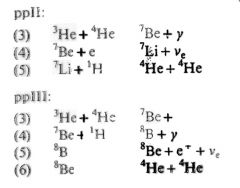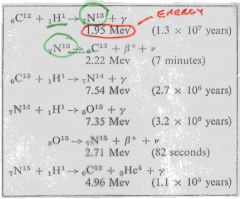![]()
![]()
![]()
Use LEFT and RIGHT arrow keys to navigate between flashcards;
Use UP and DOWN arrow keys to flip the card;
H to show hint;
A reads text to speech;
36 Cards in this Set
- Front
- Back
|
Reactions which fuse hydrogen to helium..
|
-happen in stages
-varied amounts of intermediate products are produced depending on whether or not there is "bottle-neck" in the stage of the proceedings |
|
|
rate of fuel consumption, the potential lifetime of the sun depend on..
|
slow changes in the composition and the structure
|
|
|
alternative branches of the pp cycle
|
-momentary creation of other light elements, including lithium, boron, an beryllium, which participate in later reactions, NET EFFECT: converting hydrogen to helium
|
|
|
CNO CYCLE
|
-if a star contains small amount of carbon
-carbon, nitrogen, and oxygen act as a catalyst |
|
|
Exception to true catalyst definition
|
C, N, and O do actively participate, but at the end of the cycle they wind up unchanged
|
|
|
CNO cycle is important to which stars..
|
stars that are much hotter than the sun
|
|
|
neutrinos
|
-interact with all ordinary matter, pass through essentially unaffected through the sun's outer parts , HARD TO DETECT AND COUNT
|
|
|
How many kinds of neutrinos are there?
|
- 3 flavours, produced in different ways by different particles in various reactions and decays
|
|
|
The pp cycle in the sun produces which kind of neutrino?
|
-ONLY ONE KIND, called electron neutrinos
|
|
|
First experiment to find neutrinos, what was wrong with it?
|
-used tank of cleaning fluid
-no directionality sensitivity (not sure that neutrinos were coming from the sun) -chlorine rich fluid was not the most sensitive technique -sensitive to only one kind of neutrino |
|
|
Experiment detected fewer than half of the numbers of neutrinos expected, why?
|
1.Experiment faulty in some way
2. sun was not producing as many neutrinos as theory predicted 3. neutrinos left the sun in one form, but some of them turned into different kind of neutrino, NEUTRINO MIXING |
|
|
SUDBURY Neutrino Observatory has..
|
1. Directionality
2. Time discrimination 3. better sensitivity 4. ability to detect all three kind of neutrinos |
|
|
Neutrinos can interact with heavy water in few ways..
|
1. an electron will be accelerated to a accelerated to a greater speed than the speed of light in water
2. inward-looking phototubes 3. record time and direction from where neutrino came from and sensitivity for ALL 3 kinds of neutrino |
|
|
Neutrino mixing DOES occur..
|
-the neutrinos are changing flavour from one kind to another
|
|
|
Experiment detected fewer than half of the numbers of neutrinos expected, why?
|
1.Experiment faulty in some way
2. sun was not producing as many neutrinos as theory predicted 3. neutrinos left the sun in one form, but some of them turned into different kind of neutrino, NEUTRINO MIXING |
|
|
SUDBURY Neutrino Observatory has..
|
1. Directionality
2. Time discrimination 3. better sensitivity 4. ability to detect all three kind of neutrinos |
|
|
Neutrinos can interact with heavy water in few ways..
|
1. an electron will be accelerated to a accelerated to a greater speed than the speed of light in water
2. inward-looking phototubes 3. record time and direction from where neutrino came from and sensitivity for ALL 3 kinds of neutrino |
|
|
Neutrino mixing DOES occur..
|
-the neutrinos are changing flavour from one kind to another
|
|
|
The pp cycle, how long does a deuterons last in the sun?
|

|
|
|
Probabilities in the PP cycle are called
|

branching ratios
|
|
|
CNO cycle
|
catalysed process
|
|
|
C,N,O are catalyst but..
|
they actually participate in the reactions, so they are not catalyst in the strict sense, but in the end of the cycle there is NO NET CHANGE
|
|
|
CNO cycle
|
catalysed process
|
|
|
C,N,O are catalyst but..
|
they actually participate in the reactions, so they are not catalyst in the strict sense, but in the end of the cycle there is NO NET CHANGE
|
|
|
What happens in the CNO cycle?
|

|
|
|
What cycle is dominant in the sun?
|
-PP cycle, they proceed very quickly
-CNO not as much because it is hard to push a proton into carbon nucleus , need higher temperatures for this |
|
|
PP cycle and CNO cycle have different temperature dependences, what does this mean?
|
1. both PP and CNO are very sensitive to temperature, so a bit of temperature change causes vigorous nuclear reactions
2. CNO cycle is more sensitive to temperatures than PP cycle |
|
|
In what form is the energy released from the sun?
|
PHOTONS (gamma rays and other high energy photons)
|
|
|
Do the photons come shooting out from the sun?
|
NO because material is so dense that the photon can only travel small distances
-light comes out very slowly |
|
|
DRUNKARD WALK
|
after 100 random staggering steps, the drunkard will probably be about 10 steps from the door
this means: COMPLETELY RANDOM 50:50 CHANCE OF STAGGERING ONE WAY OR THE OTHER |
|
|
Since it doesn't make sense that the trusted conservation law should be abandon, there must be another particle in this equation..
|
Criteria:
1. carry no charge 2. be of very low mass 3. interact very little with ordinary matter 4. carry the right amount of momentum to make up the shortfall |
|
|
Since it doesn't make sense that the trusted conservation law should be abandon, there must be another particle in this equation..
|
Criteria:
1. carry no charge 2. be of very low mass 3. interact very little with ordinary matter 4. carry the right amount of momentum to make up the shortfall |
|
|
How did the first experiment work for detecting neutrino existence?
|
1. Helium gas bubble through cleaning fluid
2. Tank sits for several weeks/months 3. Another sweep of helium gas brings new Ar atoms that were produced 4. Measure radioactive decay rates |
|
|
How did the first experiment work for detecting neutrino existence?
|
1. Helium gas bubble through cleaning fluid
2. Tank sits for several weeks/months 3. Another sweep of helium gas brings new Ar atoms that were produced 4. Measure radioactive decay rates |
|
|
How was the Sudbury experiment designed?
|
1. spherical vessel fluid with heavy water, deuterium
2. transparents acrylic plastic 3. emitted electron that will in general be moving faster than the speed of light in water 4. fast moving particle gives off a cone of light in the direction it is travelling (Cerenkov radiation) |
|
|
How was the Sudbury experiment designed?
|
1. spherical vessel fluid with heavy water, deuterium
2. transparents acrylic plastic 3. emitted electron that will in general be moving faster than the speed of light in water 4. fast moving particle gives off a cone of light in the direction it is travelling (Cerenkov radiation) |

